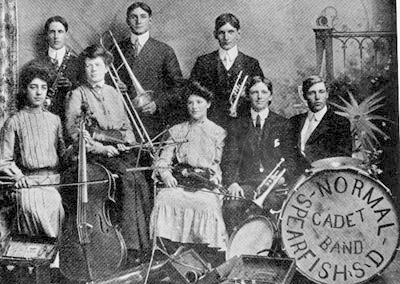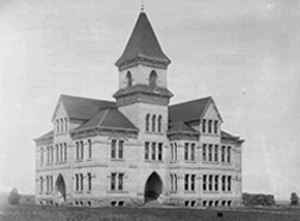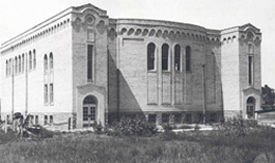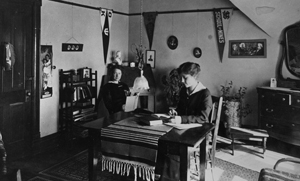EXCERPTS TAKEN FROM A HISTORY WRITTEN BY PAUL HAIVALA, PROFESSOR OF HISTORY (1965-1991)

Black Hills State University has enjoyed a long and successful history of educating the citizens of South Dakota and the west river region. Before South Dakota had even gained statehood, the people of Black Hills Dakota Territory demonstrated a high regard for education and began advocating for a university in the Black Hills. Dakota Territorial Normal School was founded in 1883. Approximately $800 was raised for the purchase of 40 acres of land. The Dakota Territorial Normal School at Spearfish became a reality in 1883, with a total budget of $2,000 for the first two years of operation.
By the end of the first term in , some 40 students were in attendance. All were studying to hold teaching positions in the region.
In , Fayette L. Cook, Superintendent of Schools for Olmstead County, Minnesota, was hired to be principal (later president) of what was now known as Spearfish Normal. After thirty-four years of service, Professor Cook retired in 1919 having created a stable and successful institution for teacher training for the citizens of South Dakota.

In 1919, E.C. Woodburn was appointed president of State Normal. In his tenure as president he undertook many changes, some planned and others unexpected. By 1922, State Normal began to offer four-year degrees. In 1941, the college was renamed Black Hills Teachers College, reflecting its mission and curriculum.
Dr. Russell E. Jonas succeeded President Woodburn in 1942 as president of Black Hills Teachers College. Enrollment declined during World War II, as was the case for most colleges and universities of their day. BHTC responded to the war effort by hosting the training operations for Air Corp Cadets for the War Manpower Commission. After the war, with the help of the G.I. Bill of Rights, enrollment grew rapidly.
By the fall of 1967, when Dr. Jonas retired and turned the reins over to President M.N. Freeman, the enrollment reached 1,936 students. Academic opportunities at BHTC continued to grow. In 1953 Black Hills State Teachers College began offering graduate courses in education. Also in 1961, BHTC signed a Memorandum of Understanding with the United States Air Force to offer classes at nearby Ellsworth Air Force Base in Rapid City. In 1964, the higher education institution was officially designated Black Hills State College.

Dr. J. Gilbert Hause became president of Black Hills State College on . President Hause saw the institution through some very turbulent times and retired from the presidency in 1985.
Dr. Clifford Trump became president on . Under his leadership the community of Spearfish and the University sought and received joint approval to construct a shared facility for recreation and health. The Donald E. Young Sports and Fitness Center is a landmark for the University and provides an ongoing linkage between the needs of our host town and the students.
As the 1990s approached, Black Hills State College was recognized officially as Black Hills State University. While still maintaining our mission of preparing educators for South Dakota, the university now served the populace with majors in the areas of Business & Technology and Arts & Sciences.
Black Hills State University is now an institution comprised of 123 acres of land overlooking the city of Spearfish. Twenty-one main buildings, serve the students and 132 full-time faculty members. Three colleges — the College of Business and Natural Resources, the College of Education and Behavioral Sciences, and the College of Liberal Arts — offer 75 degree programs: five at the associate degree level, seven at the master’s level and 63 baccalaureate degree programs. Our distance education offerings are growing each year, reaching more of our place-bound South Dakota residents. Innovation in research has more than quadrupled the grant funding received by faculty members at this institution, as each year they bring new interests and energy to the campus.

As BHSU moves decisively into the 21st Century, our original mission of service to South Dakota and the provision of a quality education remain intact. New ventures do not dim our original commitment to educating the citizens of our region. Our students perform at or above the national average on all measures of competencies, both general and content area-specific. We are proud of the institution, our history, and our legacy of dedicated faculty, staff, and students.
Take The Next Step

